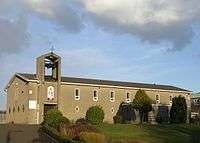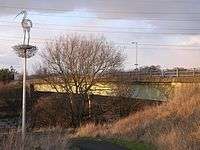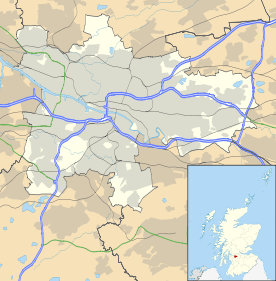Carmyle
Coordinates: 55°49′50″N 4°09′19″W / 55.8305°N 4.1552°W
Carmyle (An Càrn Maol in Gaelic) is a suburb in the east end of Glasgow, north of the River Clyde.
Transport
Carmyle railway station which opened in August 1866, closed in 1964 but then re-opened again in 1993, is on the Whifflet Line. It is an unstaffed, 2-platform halt.[1] Trains run to Glasgow Central and Rutherglen from Westbound Platform 1, and to Mount Vernon, Baillieston, Bargeddie, Kirkwood and Whifflet from Eastbound Platform 2. The service is operated by Abellio ScotRail.
The village also has a regular bus service to Glasgow City Centre, The Forge Shopping Centre (Parkhead) and Cambuslang.[2]
The village is also close to the M74 motorway giving easy access to Scotland's Central Belts, the Borders and beyond. Construction on the extension project, extending the M74 from Carmyle to Glasgow City Centre, began in May 2008 and was completed in 2011.
Due to its physical isolation from the main built-up areas of Glasgow, Carmyle has something of a rural village character as opposed to a neighbourhood in a city. The River Clyde runs to the south of the district, opposite the Westburn district of Cambuslang in South Lanarkshire – the banks were previously connected by Westburn Viaduct, a disused rail bridge, but that has now been blocked off. The closest Glasgow suburbs to the north (on the other side of the railway lines and motorway) are Auchenshuggle and Mount Vernon.
History
Carmyle as a place name, originally appears as a gift of the lands by Herbert, the Bishop of Glasgow (1147–1164) to the Cistercian Abbey of Neubotle (Newbattle, in Midlothian). This abbey had been established a few years previously by David I, whose mother, the saintly Margaret, Queen of Scotland and wife of king Malcolm III Ceanmore, had done so much to sow the seeds of Christianity in early Scotland.
The name Carmyle is derived from Gaelic and translates as "the bare cairn". The reason for this may not be too difficult to find. Originally, most of the land north of Carmyle and Tollcross was forest and brushwood, giving excellent cover for wild animals, but the strips of land alongside the river banks were very rich for cultivating. Therefore, the lands in and around Carmyle were probably cleared at an early date, so as to give room for successful agriculture. "Bare town" would be quite appropriate in the circumstances. The village has within it a residence of the Verona Fathers, in the property once known as Carmyle House.
Following on its becoming an attribute of the church through Bishop Herbert, the district was confirmed to the monks from time to time by succeeding kings and popes. A note appended to the transcript of a papal bull, dated 1263, shows that the monks had ceased to be owners, for the time being. How the change occurred is explained in a charter granted by John Cheyam, Bishop of Glasgow, on 11 June 1268. It appears that the bishop had, with his own money and with the help of Sir Reginald of Irewyn, Archdeacon of Glasgow, purchased, or redeemed, the land of Kermil. Being zealous for the increase of divine service in Glasgow Cathedral, he dedicated the property (except the new mill which he had erected on the water of the Clyde) for sustenance of three chaplains or priests, to celebrate divine service in the Cathedral for the souls of the predecessors and successors of Archdeacon Reginald. Bishop John's pious arrangement, however, seems to have been disregarded by Robert Wishart, the succeeding bishop. His interference led the dean and chapter to appeal to the Pope in 1275, for redress. The bishops of Dunblane and Argyle were commanded by the Pope to investigate the matter, but the final outcome was never documented.
The district and village were known by various names, and we've come across Carmyld, Karmyle, Kermil, Neddyr Carmyle, Overe Carmyle and Wester Carmyled. The name Hutchesoune was applied to the district called Nether Carmyle, having been added in or about the year 1579, to the lands now owned by Thomas Hutcheson. His two sons were the founders of the hospital and school in Glasgow, bearing their name.[3]
Carmyle Church
The current Carmyle Church of Scotland situated in Carmyle Avenue was built in 1907, costing an estimated £2,500. The Church was formally opened with a dedication service held on Thursday 7 March 1907, and performed by the Rev. Alex White, D.D., of St Georges, Edinburgh. As well as weekly services the church is used by the local community for Brownies, Mother and Toddler groups and a regular thrift shop. Carmyle Church is a linked charge with Kenmuir Mount Vernon Church of Scotland on London Road with the one minister serving both congregations. Both Carmyle and Kenmuir are also linked via a parish grouping with Sandyhills Church of Scotland. Services are held at Carmyle Church every Sunday at 12:00pm.
St. Joachim’s RC Church

Like so many other areas in the west of Scotland, the Reformation and foundation of the Protestant Reformed Kirk saw the almost complete removal of the Catholic faith from Carmyle and the land transferred into secular hands. It was not until 1829 and the Catholic Emancipation Act that punitive laws against Catholicism were relaxed and the old Church begin to re-establish itself in Scotland. There had been an influx of Catholics from the Highlands as well as from Ireland during the progress of the Industrial Revolution and this was reflected in the growing population of Carmyle. However, it was not until the mid-20th century that numbers increased to the extent that the area warranted provision independent of St. Joseph’s Tollcross parish, of which it had until then formed a part.
From March, 1954 the priests of St. Joseph’s used the local Welfare Hall to provide services to the Catholics of Carmyle, with the parish being established under the patronage of St. Joachim in July.
Carmyle Mains Steading farm on River Road was obtained and from a state of dereliction was transformed into a Chapel Hall over a 10-month period to June, 1955 by the local folk. Progress continued apace and a new church was built on an elevated piece of land at the end of Inzievar Terrace, opening in September, 1957 – the present St. Joachim’s. The parish is located within the Glasgow Archdiocese, although the village itself was not incorporated into the city until 1975 with the revision of local government boundaries.[4]
Primary schools
Carmyle Primary School achieved small notoriety in the mid-1970s when it was rebuilt in a flying saucer/open plan design, a rarity in Scotland at the time. The school was subsequently rebuilt as a modern open-plan building after its demolition in 1993 following a fire.
St. Joachim’s Primary School is affiliated with the Catholic Church of the same name. St Joachim’s, in its current guise, was built in 1975[5]
Leisure
Carmyle has two public houses and two bowling greens. The Auld Boat Hoose, or "bottom shop" in River Road, opposite the spot where a boat would ferry people across the Clyde from the Cambuslang side,[6] and the Auld Hoose, or "tap shop", round the corner, a few hundred yards up Carmyle Avenue.
Carmyle Bowling Club is situated one hundred yards from the "bottom shop" and has been a member of the Glasgow and Scottish Bowling Associations since the 1960s. Foxley Bowling Club in Carmyle Avenue was instituted in 1914. The Club took its name from the local estate called Foxley. Several residents of Carmyle are members and a friendly rivalry exists between the two clubs.[7]
Walter Smith
Walter Smith, although born in Lanark, grew up in the Gardenside area of Carmyle.[8] Walter Smith has gone on to become one of the most successful managers in Rangers history.[9]
Clydeford Bridge

Built in 1976, the Clydeford Bridge carries vehicles and pedestrians over the Clyde on the A763 road towards an industrial suburb on the site of the Clyde Iron Works, and towards the M74 motorway and A74 road. The bridge is located to the north-east of Cambuslang and the south-west of Carmyle. Its name derives from Clydeford Road which runs north from Cambuslang Main Street to the river, which was itself named for an ancient ford across the water at a nearby point. It was built to replace the Cambuslang Bridge (built 1892) located to the west - that bridge has never been demolished although it is closed to traffic.[10]
On the south side of the Clydeford bridge at the Clyde Walkway and National Cycle Route 75 is a metallic wire sculpture of a wading bird created in 1998 by noted sculptor Andy Scott. It is known as the Carmyle Heron (although it is actually on the Cambuslang side of the river).
References
- ↑ Carmyle Station Info Archived 9 September 2010 at the Wayback Machine.
- ↑ "Home".
- ↑ "Carmyle - East End Glasgow History".
- ↑ "St Joachim Carmyle - East End Glasgow History".
- ↑ "Carmyle - East End Glasgow History".
- ↑ "Carmyle - East End Glasgow History".
- ↑ "Carmyle - East End Glasgow History".
- ↑ Walter Smith
- ↑ Walter Smith Managerial Achievements
- ↑ "Glasgow, Cambuslang, Clydeford Road Bridge - Canmore".
